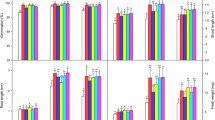Abstract
Gluconacetobacter- like diazotrophs were encountered as dense populations inside the root and stem tissues of sugarcane cultivated in ancient agricultural fields of the Nile Delta. Counts of >105 cells g-1 were recorded in root and stem samples. The leaves contained a smaller population (<103 g-1). The typical dark-orange colonies which developed on LGIP agar plates were purified. Identification was performed with the API microtube systems: API 20E for Enterobacteriaceae and API 20NE for non-Enterobacteriaceae. API profiles of the local isolates were closely related to those of the type culture Gluconacetobacter diazotrophicus (ATTC 49037). The isolates successfully reduced C2H2 and produced appreciable amounts of ethylene in the presence of cane juice. This suggested that the local isolates are closely related to the type strain G. diazotrophicus. Wheat seedlings were inoculated with a number of isolates under gnotobiotic conditions. Both optical and scanning electron microscopy showed that endophytic Gluconacetobacter spp. were present in all the samples tested. They were observed in apparently intact and enlarged epidermal root cells, and also in stem tissues, indicating that the bacterium was able to migrate upward into the shoot tissues. Although Gluconacetobacter inoculation did not stimulate the growth of the cereal plant, the results obtained are particularly interesting because this bacterial species was capable of colonizing the internal tissues of wheat, not considered a natural host until now.




Similar content being viewed by others
References
Alexander M (1982) Most probable number for microbial populations. In: Page AL (ed) Methods of soil analysis, part 2. American Society of Agronomy, Soil Science Society of America, Madison, Wis., pp 815–820
Bilal R, Rasul G, Qureshi JA, Malik KA (1990) Characterization of Azospirillum and related diazotrophs associated with roots of plants growing in saline soils. World J Microbiol Biotechnol 6:46–52
Burris RH (1994) Comparative study of the response of Azotobacter vinelandii and Acetobacter diazotrophicus to changes in pH. Protoplasma 183:62–66
Cavalcante VA, Dobereiner J (1988) A new acid-tolerant nitrogen-fixing bacterium associated with sugar cane. Plant Soil 108:23–31
Cojho EH, Reis VM, Schenberg AC, Dobereiner J (1993) Interactions of Acetobacter diazotrophicus with an amylolytic yeast in nitrogen-free batch culture. FEMS Microbiol Lett 106:341–346
Dobereiner J (1992) History and new perspectives of diazotrophs in association with non-leguminous plants. Symbiosis 13:1–13
Dobereiner J, Reis V, Lazarini AC (1988) New N2-fixing bacteria in association with cereals and sugarcane. In: Bothe H, de Bruijn FJ, Newton WE (eds) Nitrogen fixation: one hundred years after. Fischer, Stuttgart, pp 717–722
Fuentes-Ramirez LE, Jimenez-Salgado T, Abarca-Ocampo IR, Caballero-Mellado J (1993) Acetobacter diazotrophicus, an indole acetic acid producing bacterium isolated from sugarcane cultivars of Mexico. Plant Soil 154:145–150
Gagne S, Richard C, Rousseau H, Antoun H (1987) Xylem-residing bacteria in alfalfa roots. Can J Microbiol 33:996–1000
Gillis M, Kersters K, Hoste B, Janssens D, Kroppensted’r RM, Stephan MP, Teixeira KRS, Dobereiner J, Deley J (1989) Acetobacter diazotrophicus sp. nov., a nitrogen-fixing acetic acid bacterium associated with sugarcane. Int J Syst Bacteriol 39:361–364
Harley MM, Fergusen IK (1990) The role of the SEM in pollen morphology and plant systematic. In: Claugher D (ed) Scanning electron microscope in taxonomy and functional morphology. (Systemics Association special volume) Clarendon press, Oxford, pp 45–68
Hegazi NA, Amer HA, Monib M (1980) Studies on N2-fixing spirilla ( Azospirillum spp.) in Egyptian soil. Rev Ecol Biol Soil 17:491–499
Krieg NR, Holt JG (1984) Bergey’s manual of systematic bacteriology, 1st edn. Williams and Wiilkins, Baltimore, Md.
Li RP, MacRae IC (1991) Specific association of diazotrophic acetobacters with sugarcane. Soil Biol Biochem 23:999–1002
Li RP, MacRae IC (1992) Specific identification and enumeration of Acetobacter diazotrophicus in sugarcane. Soil Biol Biochem 24:413–419
Logan NA, Berkeley RCW (1984) Identification of Bacillus strains using the API system. J Can Microbiol 130:1871–1882
Patriquin DG, Dobereiner J (1978) Light microscopy observations of tetrazolium-reducing bacteria in the endorhizosphere of maize and other grasses in Brazil. Can J Microbiol 24:734–742
Paula MA, Reis VM, Dobereiner J (1991) Interactions of Glomus clarum with Acetobacter diazotrophicus in infection of sweet potato ( Ipomoea batatas), sugar cane ( Saccharum spp.), and sweet sorghum ( Sorghum vulgare). Biol Fertil Soils 11:111–115
Reinhold B, Hurek T, Fendrik I (1985) Strain-specific chemotaxis of Azospirillum spp. J Bacteriol 162:190–195
Reis VM (1991) MSc thesis. UFRRJ, Seropedica-RJ, Brazil, 119 p
Reis VM, Olivares FL, Dobereiner J (1994) Improved methodology for isolation of Acetobacter diazotrophicus and confirmation of its endophytic habitat. World J Microbiol Biotechnol 10:101–104
Somasegaran P, Hoben HJ (1985) Methods in legume- Rhizobium technology. In: University of Hawaii NifTAL Project (ed). MIRCEN Department of Agronomy and Soil Science, Hawaii Institute of Tropical Agriculture and Human Resources, College of Tropical Agriculture and Human Resources, Hawaii, pp 7–9
Stephan MP, Oliveira M, Teixeira KRS, Martinez-Drets G, Dobereiner J (1991) Physiology and dinitrogen fixation of Acetobacter diazotrophicus. FEMS Microbiol Lett 77:67–72
Acknowledgements
Thanks are due to Prof. S. El-Deeb at the Plant Pathology Department, the Faculty of Agriculture, Ain Shams University for his unlimited support during the electron microscopic examinations of plant samples. The very important botanical information of Prof. K. El-Sahaar of the Faculty of Agriculture, Cairo University is very much appreciated. This study was supported by the research grant BLAFE /FC/31/3–94 offered by the National Project on Agro-Technologies Based on Biological Nitrogen Fixation for the Development of Sinai Agriculture.
Author information
Authors and Affiliations
Corresponding author
Rights and permissions
About this article
Cite this article
Youssef, H.H., Fayez, M., Monib, M. et al. Gluconacetobacter diazotrophicus: a natural endophytic diazotroph of Nile Delta sugarcane capable of establishing an endophytic association with wheat. Biol Fertil Soils 39, 391–397 (2004). https://doi.org/10.1007/s00374-004-0728-4
Received:
Accepted:
Published:
Issue Date:
DOI: https://doi.org/10.1007/s00374-004-0728-4




